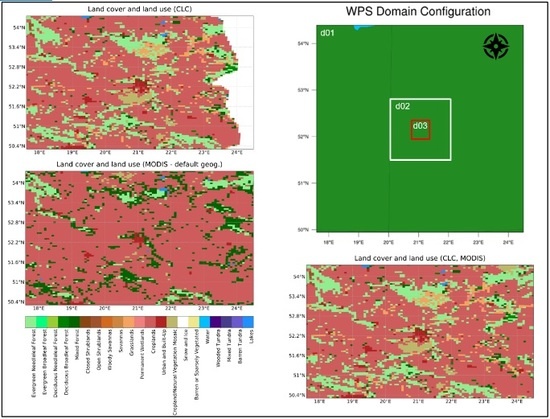GIS Data as a Valuable Source of Information for Increasing Resolution of the WRF Model for Warsaw
Abstract
1. Introduction
2. Methods and Materials
2.1. Methodology
2.2. Study Area
2.3. WRF Specification
2.4. Land Use and Land Cover
2.5. Terrain Elevation Data
2.6. WRF Binary Format—Methods of Generation
3. Results
Verifiability of Meteorological Parameters
4. Discussion
5. Conclusions
Author Contributions
Funding
Acknowledgments
Conflicts of Interest
References
- Petrişor, A.I. Using CORINE data to look at deforestation in Romania: Distribution & possible consequences. Urbanism. Arhit. Construcţii 2015, 6, 83–90. [Google Scholar]
- Thibbotuwawa, A.; Bocewicz, G.; Nielsen, P.; Banaszak, Z. Planning deliveries with UAV routing under weather forecast and energy consumption constraints. IFAC-PapersOnLine 2019, 52, 820–825. [Google Scholar] [CrossRef]
- Oleniacz, R.; Rzeszutek, M. Intercomparison of the CALMET/CALPUFF Modeling System for Selected Horizontal Grid Resolutions at a Local Scale: A Case Study of the MSWI Plant in Krakow, Poland. Appl. Sci. 2018, 8, 2301. [Google Scholar] [CrossRef]
- De Meij, A.; Vinuesa, J.F. Impact of SRTM and Corine Land Cover data on meteorological parameters using WRF. Atmos. Res. 2014, 143, 351–370. [Google Scholar] [CrossRef]
- Huang, M.; Wang, Y.; Lou, W.; Cao, S. Multi-scale simulation of time-varying wind fields for Hangzhou Jiubao Bridge during Typhoon Chan-hom. J. Wind Eng. Ind. Aerodyn. 2018, 179, 419–437. [Google Scholar] [CrossRef]
- Li, H.; Wolter, M.; Wang, X.; Sodoudi, S. Impact of land cover data on the simulation of urban heat island for Berlin using WRF coupled with bulk approach of Noah-LSM. Theor. Appl. Climatol. 2018, 134, 67–81. [Google Scholar] [CrossRef]
- De Meij, A.; Zittis, G.; Christoudias, T. On the uncertainties introduced by land cover data in high-resolution regional simulations. Meteorol. Atmos. Phys. 2019, 131, 1213–1223. [Google Scholar] [CrossRef]
- Gondocs, J.; Breuer, H.; Pongracz, R.; Bartholy, J. Urban heat island mesoscale modelling study for the Budapest agglomeration area using the WRF model. Urban Clim. 2017, 21, 66–86. [Google Scholar] [CrossRef]
- Karsisto, V.; Nurmi, P.; Kangas, M.; Hippi, M.; Fortelius, C.; Niemela, S.; Järvinen, H. Improving road weather model forecast by adjusting the radiation input. Meteorol. Appl. 2016, 23, 503–513. [Google Scholar] [CrossRef][Green Version]
- Calvo-Sánchez, J.; Morales-Martin, G. Wind Field Deterministic Forecasting. In Wind Field and Solar Radiation Characterization and Forecasting. A Numerical Approach for Complex Terrain; Perez, R., Ed.; Springer: Basel, Switzerland, 2018; pp. 113–128. [Google Scholar] [CrossRef]
- Carvalho, D.; Rocha, A.; Silva Santos, C.; Pereira, R. Wind resources modelling in complex terrain different mesoscale-microscale coupling techniuques. Appl. Energy 2013, 108, 493–504. [Google Scholar] [CrossRef]
- Wang, W.; Bruyère, C.; Duda, M.; Duda, M.; Dudhia, J.; Gill, D.; Kavulich, M.; Werner, K.; Chen, M.; Lin, H.-C.; et al. Weather Research & Forecasting Model. ARW Version 4 Modeling System User’s Guide; Mesoscale and Microscale Meteorology Laboratory NCAR: Boulder, CO, USA, 2019; Available online: https://www2.mmm.ucar.edu/wrf/users/docs/user_guide_V4/WRFUsersGuide.pdf (accessed on 20 April 2020).
- Chen, F.; Liu, Y.; Kusaka, H.; Tewari, M.; Bao, J.W.; Lo, C.F.; Lau, K.H. Challenge of Forecasting Urban Weather with NWP Models. In Proceedings of the First Joint WRF/MM5 User’s Workshop, Boulder, CO, USA, 22–25 June 2004. [Google Scholar]
- Beezley, J.D.; Kochanski, A.K.; Kondratenko, V.Y.; Mandel, J. Integrating high-resolution static data into WRF for real fire simulations. In Proceedings of the Ninth Symp. Fire For. Meteorol., Palm Springs, CA, USA, 18–20 October 2011. [Google Scholar]
- Chen, F.; Kusaka, H.; Bornstein, R.; Ching, J.; Grimmond, C.S.B.; Grossman-Clarke, S.; Loridan, T.; Manning, K.W.; Martilli, A.; Miao, S.; et al. The integrated WRF/urban modeling system: Development, evaluation, and applications to urban environmental problems. Int. J. Climatol. 2011, 31, 273–288. [Google Scholar] [CrossRef]
- Jose, R.S.; Pérez, J.L. Mesoscale meteorological models in the urban context. In Understanding Urban Metabolism, A Tool for Urban Planning; Chrysoulakis, N., de Castro, A., Moors, E.J., Eds.; Routeladge Press Taylor & Francis Group: London, UK; New York, NY, USA, 2015; pp. 69–78. ISBN 978-1-315-76584-6. [Google Scholar]
- Dimitrova, R. Modeling the Impact of Urbanization on Local Meteorological Conditions in Sofia. Atmosphere 2019, 10, 366. [Google Scholar] [CrossRef]
- Li, X.; Mitra, C.; Dong, L.; Yang, Q. Understanding land use change impacts on microclimate using Weather Research and Forecasting (WRF) Model. Phys. Chem. Earth 2018, 103, 115–126. [Google Scholar] [CrossRef]
- Trihamdani, A.R.; Kubota, T.; Lee, H.S.; Sumida, K.; Phuong, T.T.T. Impacts of Land Use Changes on Urban Heat Islands in Hanoi, Vietnam: Scenario Analysis. Procedia Eng. 2017, 198, 525–529. [Google Scholar] [CrossRef]
- Schicker, I.; Arnold Arias, D.; Seibert, P. Influences of updated land-use datasets on WRF simulations for two Austrian regions. Meteorol. Atmos. Phys. 2016, 128, 279–301. [Google Scholar] [CrossRef]
- Chen, L.; Ma, Z.; Fan, X. A comprehensive study of two land surface schemes in WRF model over Eastern China. J. Trop. Meteorol. 2012, 18, 445–456. [Google Scholar]
- Jandaghian, Z.; Akbari, H. The Effect of Increasing Surface Albedo on Urban Climate and Air Quality: A Detailed Study for Sacramento, Houston, and Chicago. Climate 2018, 6, 19. [Google Scholar] [CrossRef]
- Morini, E.; Touchaei, A.G.; Castellani, B.; Rossi, F.; Cotana, F. The Impact of Albedo Increase to Mitigate the Urban Heat Island in Terni (Italy) Using the WRF Model. Sustainability 2016, 8, 999. [Google Scholar] [CrossRef]
- Jancewicz, K. Remote Sensing Data in Wind Velocity Field Modelling: A Case Study from the Sudetes (SW Poland). Pure Appl. Geophys. 2014, 171, 941–964. [Google Scholar] [CrossRef]
- Jiménez-Esteve, E.B.; Udina, M.; Soler, M.R.; Pepin, N.; Miró, J.R. Land use and topography influence in complex terrain area: A high resolution mesoscale modeling study over the Eastern Pyrenees using the WRF model. Atmos. Res. 2017. [Google Scholar] [CrossRef]
- Jancewicz, K.; Szymanowski, M. The Relevance of Surface Roughness Data Qualities in Diagnostic Modelling of Wind Velocity in Complex Terrain: A Case Study from the Śnieżnik Massif (SW Poland). Pure Appl. Geophys. 2017, 174, 569–594. [Google Scholar] [CrossRef][Green Version]
- Feranec, J.; Soukup, T.; Hazeu, G.; Jaffrain, G. (Eds.) European Landscape Dynamics: CORINE Land Cover Data, 1st ed.; CRC Press: Boca Raton, FL, USA, 2016; ISBN 9781315372860. [Google Scholar]
- Büttner, G. CORINE Land Cover and Land Cover Change Products. In Land Use and Land Cover Mapping in Europe: Practices & Trends; Manakos, I., Braun, M., Eds.; Springer: Dordrecht, The Netherlands, 2014; pp. 55–74. ISBN 978-94-007-7969-3. [Google Scholar]
- Büttner, G.; Kosztra, B. CLC 2018, Technical Guidelines; Service Contract No 3436/R0-Copernicus/EEA.56665; EEA: Wien, Austria, 2017; ISBN 92-9167-511-3. [Google Scholar]
- Luc, M.; Bielecka, E. Ontology for National Land Use/Land Cover Map: Poland Case Study. In Land Use and Land Cover Semantics; Ahlqvist, O., Varanka, D., Fritz, S., Janowicz, K., Eds.; CRS Press Taylor & Francis Group: Boca Raton, FL, USA, 2015; pp. 21–40. [Google Scholar]
- Pineda, N.; Jorba, O. Using NOAA AVHRR and SPOT VGT data to estimate surface parameters: Application to a mesoscale meteorological model. Int. J. Remate Sens. 2004, 25, 129–143. [Google Scholar] [CrossRef]
- Anderson, J.R.; Hardy, E.E.; Roach, J.T.; Witmer, R.E. A Land Use and Land Cover Classification System for Use with Remote Sensor Data, 4th ed.; United States Government Printing Office: Washington, DC, USA, 1983.
- Kumar, A.; Chen, F.; Barlage, M.; Ek, M.B.; Niyogi, D. Assessing Impact of Integrating MODIS Vegetation Data in the Weather Research and Forecasting (WRF) Model Coupled to Two Different Canopy-Resistance Approaches. J. Appl. Meteorol. Climatol. 2014, 53, 1362–1380. [Google Scholar] [CrossRef]
- Institute of Meteorology and Water Management—National Research Institute, Archive of Meteorological Observations. Available online: https://www.danepubliczne.imgw.pl (accessed on 29 April 2020).
- Czernecki, B.; Głogowski, A.; Nowosad, J. Climate: An R Package to Access Free In-Situ Meteorological and Hydrographical Datasets for Environmental Assessment. Sustainability 2020, 12, 394. [Google Scholar] [CrossRef]
- Jolliffe, I.T.; Stephenson, D.B. Forecast. Verification: A Practitioner’s Guide in Atmospheric Science, 2nd ed.; John Wiley & Sons: Chichester, UK, 2012; ISBN 978-0-470-66071-3. [Google Scholar]
- Kendzierski, S.; Czernecki, B.; Kolendowicz, L.; Jaczewski, A. Air temperature forecasts’ accuracy of selected short-term and long-term numerical weather prediction models over Poland. Geofizyka 2018, 35, 19–37. [Google Scholar] [CrossRef]
- Solon, J.; Borzyszkowski, J.; Bidłasik, M.; Richling, A.; Badora, K.; Balon, J.; Brzezińska-Wójcik, T.; Chabudziński, Ł.; Dobrowolski, R.; Grzegorczyk, I.; et al. Physico-geographical mesoregions of Poland: Verification and adjustment of boundaries on the basis of contemporary spatial data. Geogr. Pol. 2018, 91, 143–170. [Google Scholar] [CrossRef]
- Zegara, T. Statistical review of Warsaw 4th Quarter 2019, 2020, XXVIII, pp. 37–43. Available online: https://warszawa.stat.gov.pl/ (accessed on 20 April 2020).
- Skamarock, W.C.; Klemp, J.B.; Dudhia, J.; Gill, D.O.; Liu, Z.; Berner, J.; Wang, W.; Powers, J.G.; Duda, M.G.; Barker, D.M.; et al. A Description of the Advanced Research WRF Model. Version 4; (No. NCAR/TN-556+STR); National Center for Atmospheric Research: Boulder, CO, USA, 2019. [Google Scholar] [CrossRef]
- The Global Forecasting System (GFS) of the National Weather Service NCEP. Available online: https://www.nco.ncep.noaa.gov/pmb/products/gfs/ (accessed on 29 April 2020).
- Friedl, M.A.; McIver, D.K.; Hodges, J.C.F.; Zhang, X.Y.; Muchoney, D.; Strahler, A.H.; Woodcock, C.E.; Gopal, S.; Schneider, A.; Cooper, A.; et al. Global land cover mapping from MODIS: Algorithms and early results. Remote Sens. Environ. 2002, 83, 287–302. [Google Scholar] [CrossRef]
- Golenia, M.; Zagajewski, B.; Ochtyra, A. Semiautomatic land cover mapping according to the 2nd level of the CORINE Land Cover legend. Pol. Cartogr. Rev. 2015, 47, 203–212. [Google Scholar] [CrossRef]
- Pabjanek, P.; Szumacher, I. Land use and ecosystem services temporal changes in the urban sprawl zone, Warsaw, Poland. Probl. Landsc. Ecol. 2017, XLIV, 29–40. [Google Scholar]
- Cieślak, I.; Białozior, A.; Szuniewicz, K. The Use of the CORINE Land Cover (CLC) Database for Analyzing Urban Sprawl. Remote Sens. 2020, 12, 282. [Google Scholar] [CrossRef]
- Solon, J. Spatial context of urbanization: Landscape pattern and changes between 1950 and 1990 in the Warsaw metropolitan area, Poland. Landsc. Urban. Plan. 2009, 93, 250–261. [Google Scholar] [CrossRef]
- Turner, B.; Meyer, W.B.; Skole, D.L. Global land use/land cover change: Towards an integrated study. AMBIO 1994, 23, 91–95. [Google Scholar]
- Copernicus Land Monitoring Service. Available online: https://land.copernicus.eu/ (accessed on 29 April 2020).
- Danielson, J.J.; Gesch, D.B. Global Multi-Resolution Terrain Elevation Data 2010 (GMTED2010), Open-File Report 2011–1073; U.S. Department of the Interior: Mission, SD, USA; U.S. Geological Survey: Reston, VA, USA; Rolla Publishing Service Center: Rolla, MO, USA, 2011. Available online: https://pubs.usgs.gov/of/2011/1073/pdf/of2011-1073.pdf (accessed on 20 April 2020).
- Van Zyl, J.J. The Shuttle Radar Topography Mission (SRTM): A breakthrough in remote sensing of topography. Acta Astronaut. 2001, 48, 559–565. [Google Scholar] [CrossRef]
- U.S. Geological Survey (USGS). Shuttle Radar Topography Mission (SRTM) Void Filled. Available online: https://earthexplorer.usgs.gov/ (accessed on 29 April 2020).
- Farr, T.G.; Rosen, P.A.; Caro, E.; Crippen, R.; Duren, R.; Hensley, S.; Kobrick, M.; Paller, M.; Rodriguez, E.; Roth, L.; et al. The Shuttle Radar Topography Mission. Rev. Geophys. 2007, 45. [Google Scholar] [CrossRef]
- Rodriguez, E.; Morris, C.S.; Belz, J.E. A global assessment of the SRTM performance. Photogramm. Eng. Remote Sens. 2006, 72, 249–260. [Google Scholar] [CrossRef]
- Meyer, D.; Riechert, M. Open source QGIS toolkit for Advanced Research WRF modeling system, Environment Modelling and Software. Environ. Model. Softw. 2019, 166–178. [Google Scholar] [CrossRef]
- Ladwig, W. Wrf-Python; Version 1.3.2; UCAR/NCAR: Boulder, CO, USA, 2017. [Google Scholar] [CrossRef]
- He, B.-J.; Ding, L.; Prasad, D. Enhancing urban ventilation performance through the development of precinct ventilation zones: A case study based on the Greater Sydney, Australia. Sustain. Cities Soc. 2019, 47, 101472. [Google Scholar] [CrossRef]
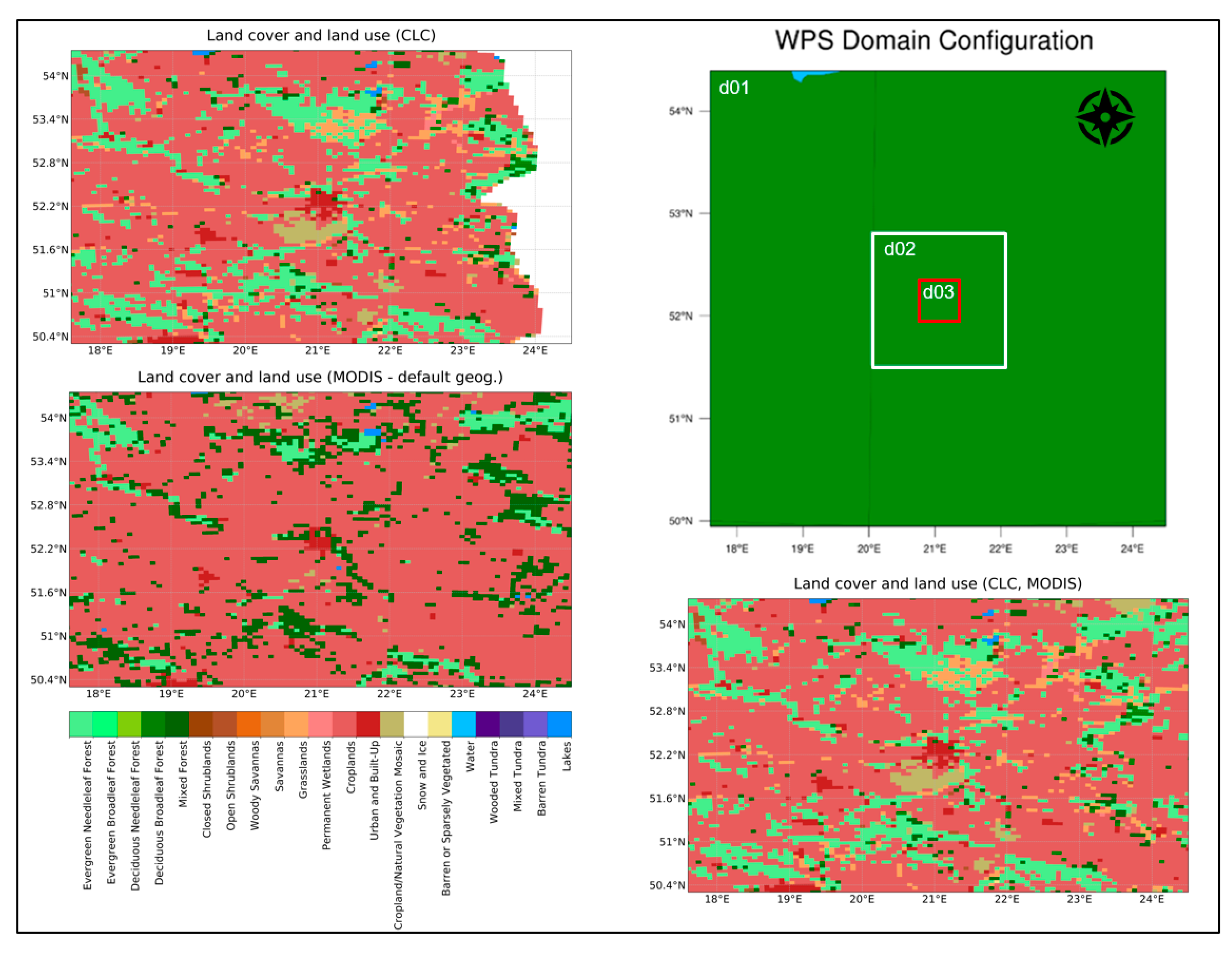
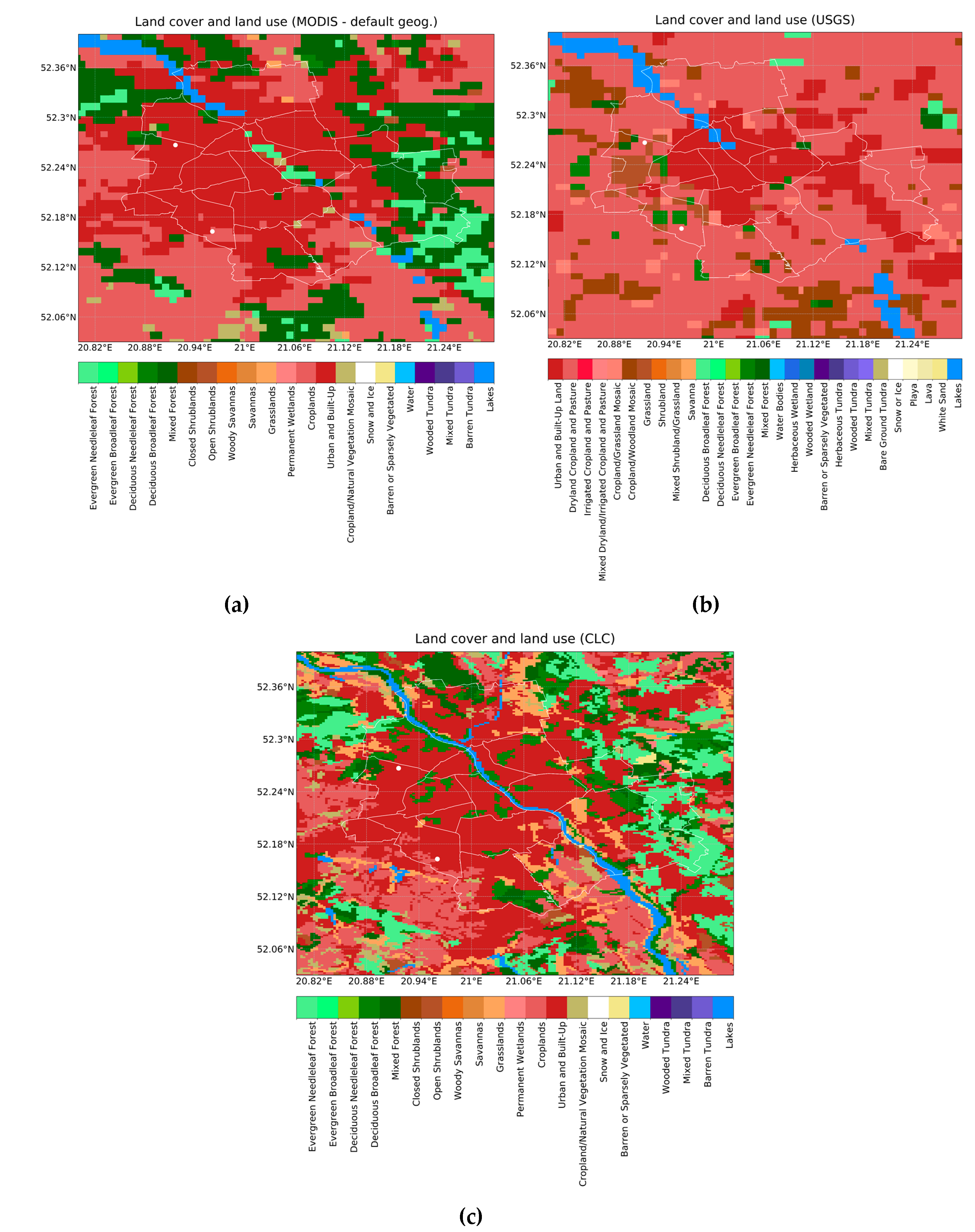
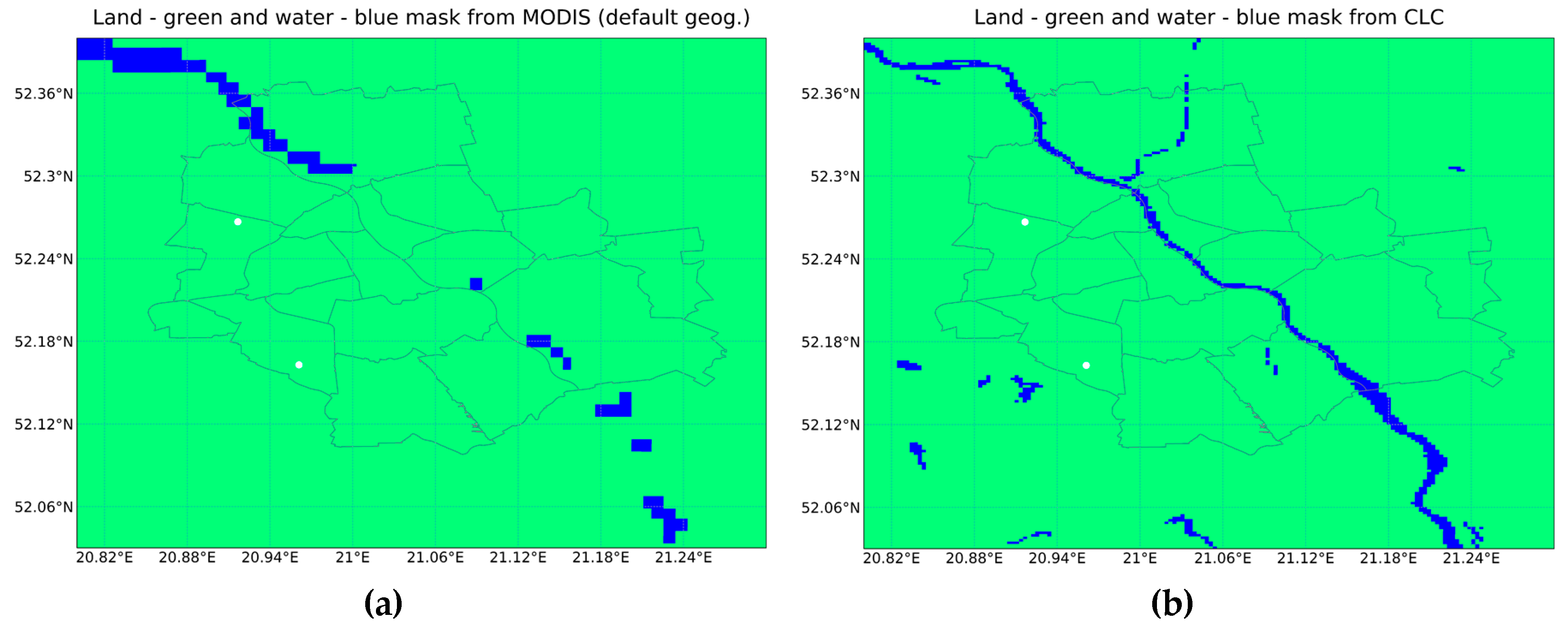
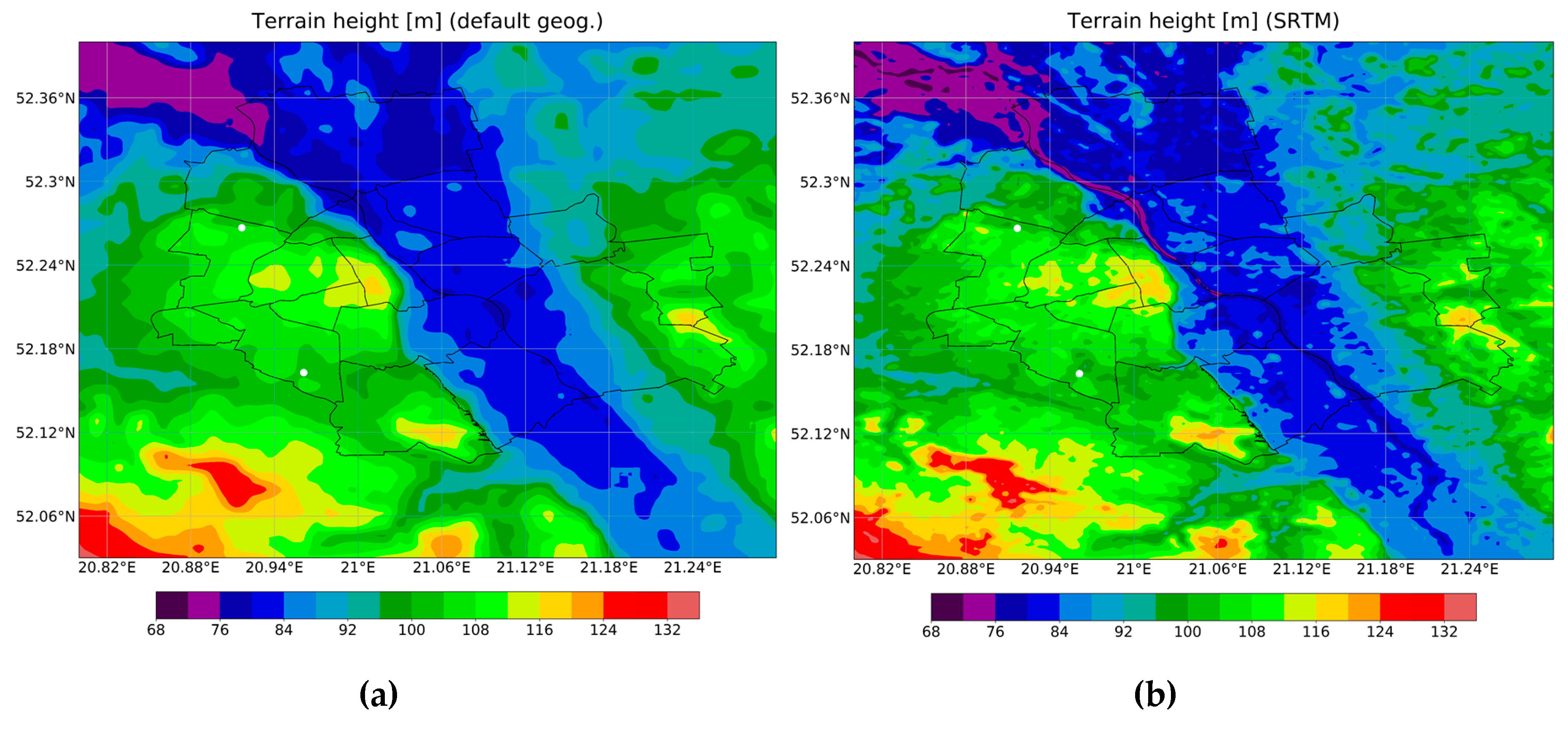
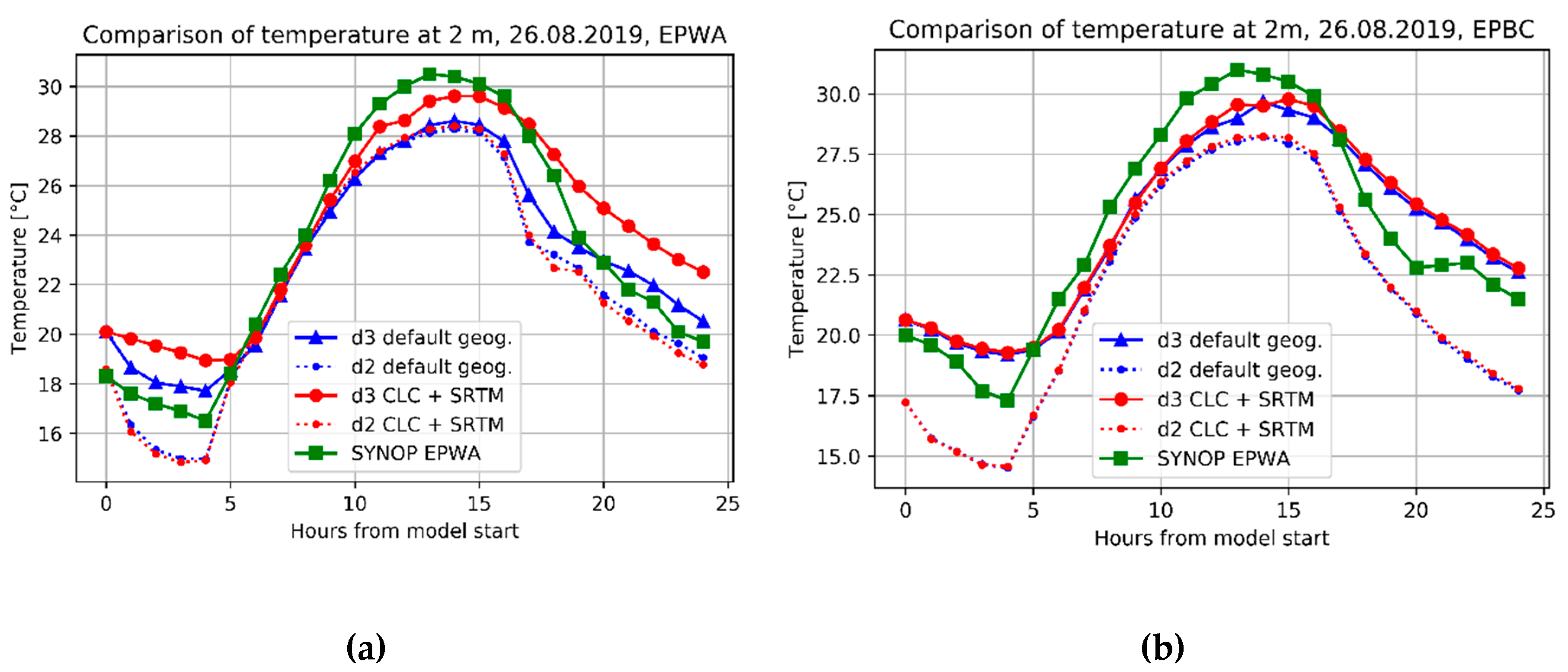
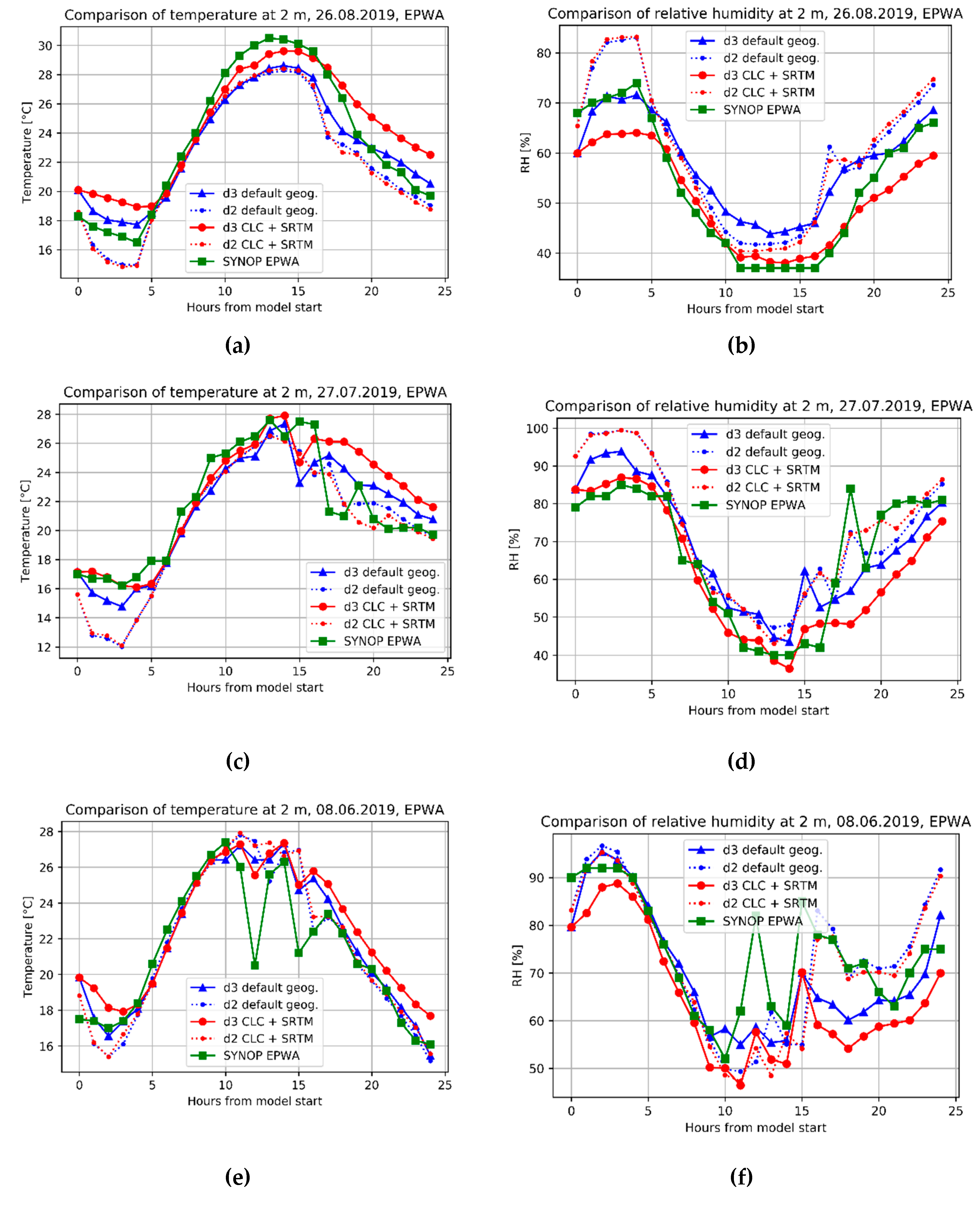
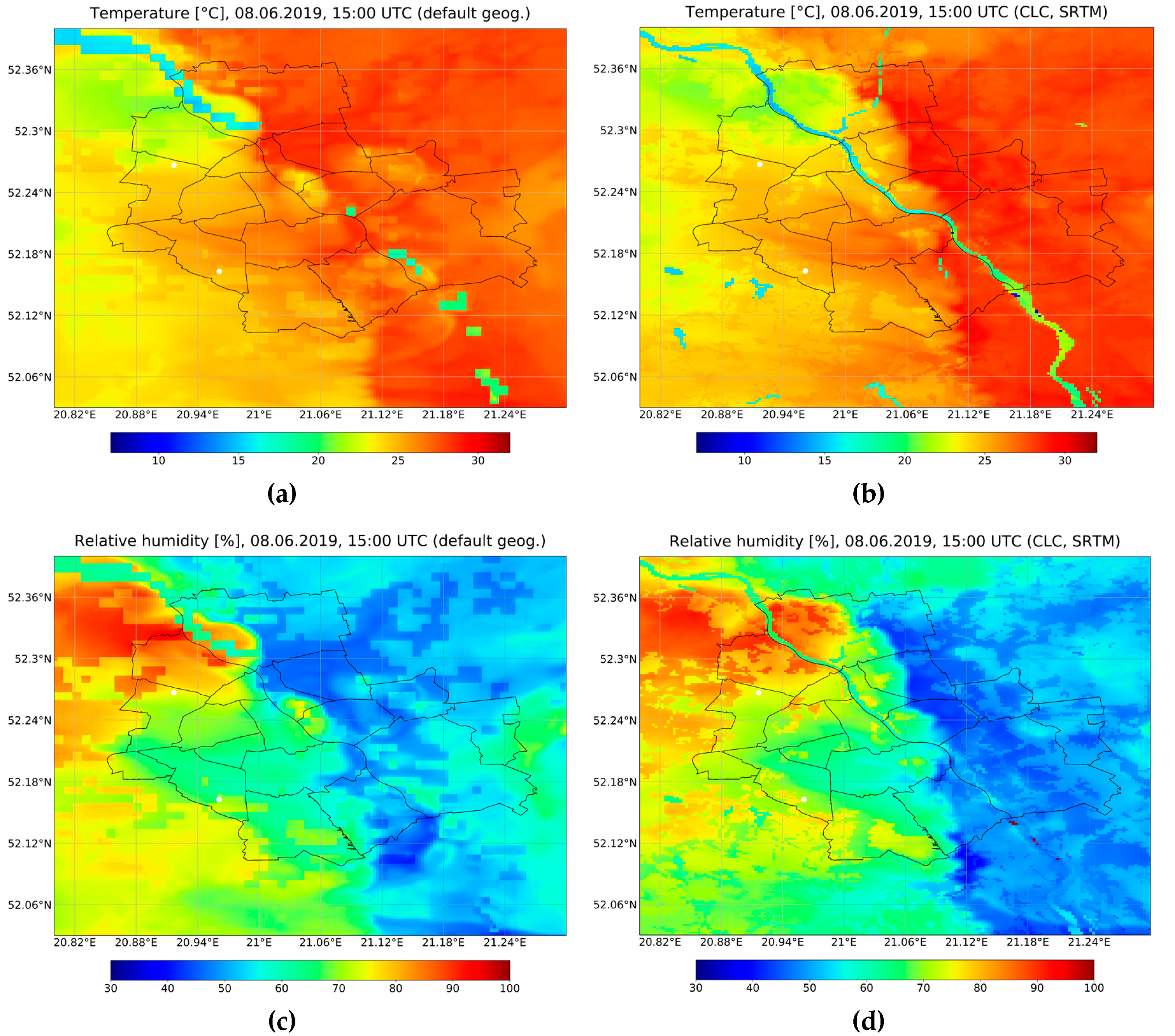
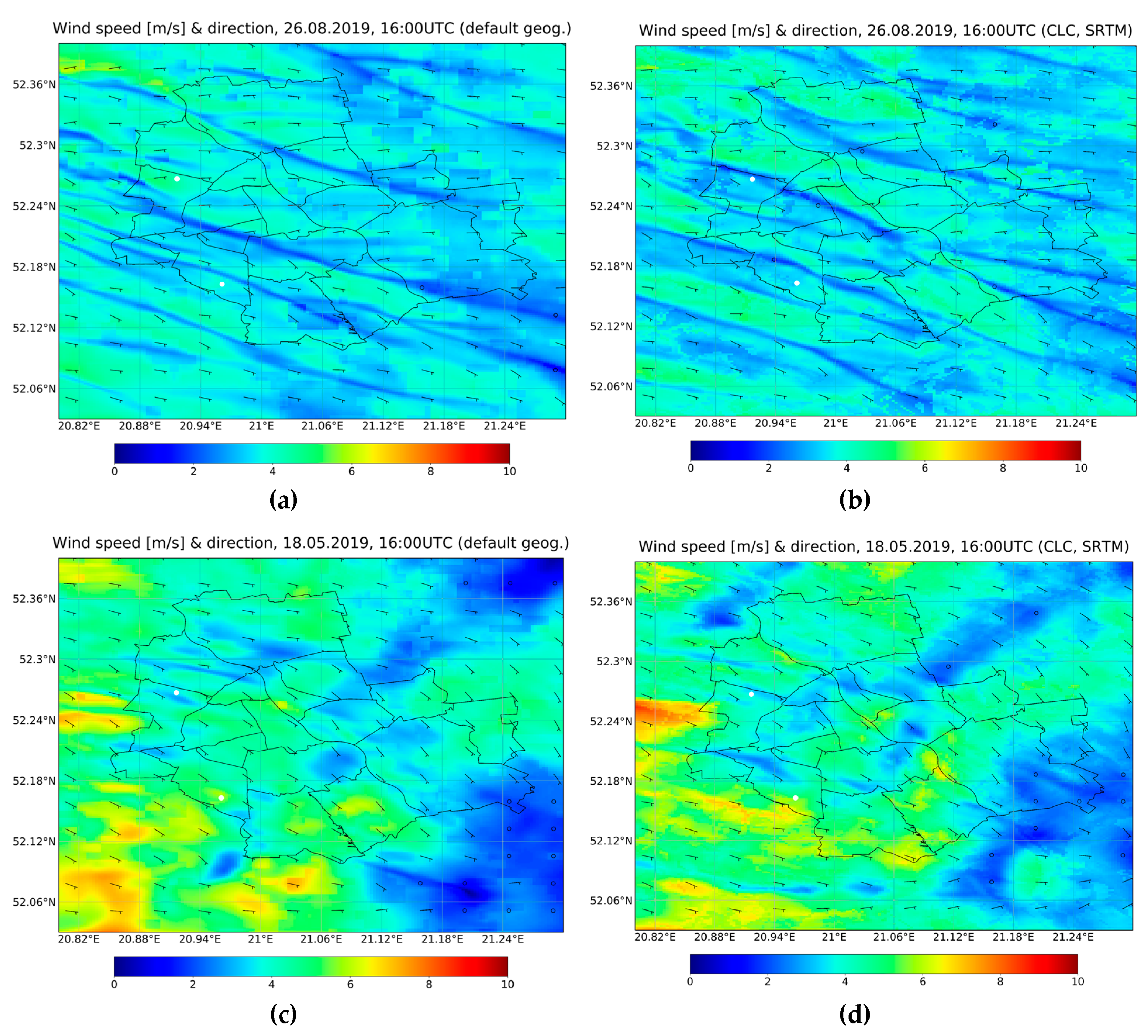
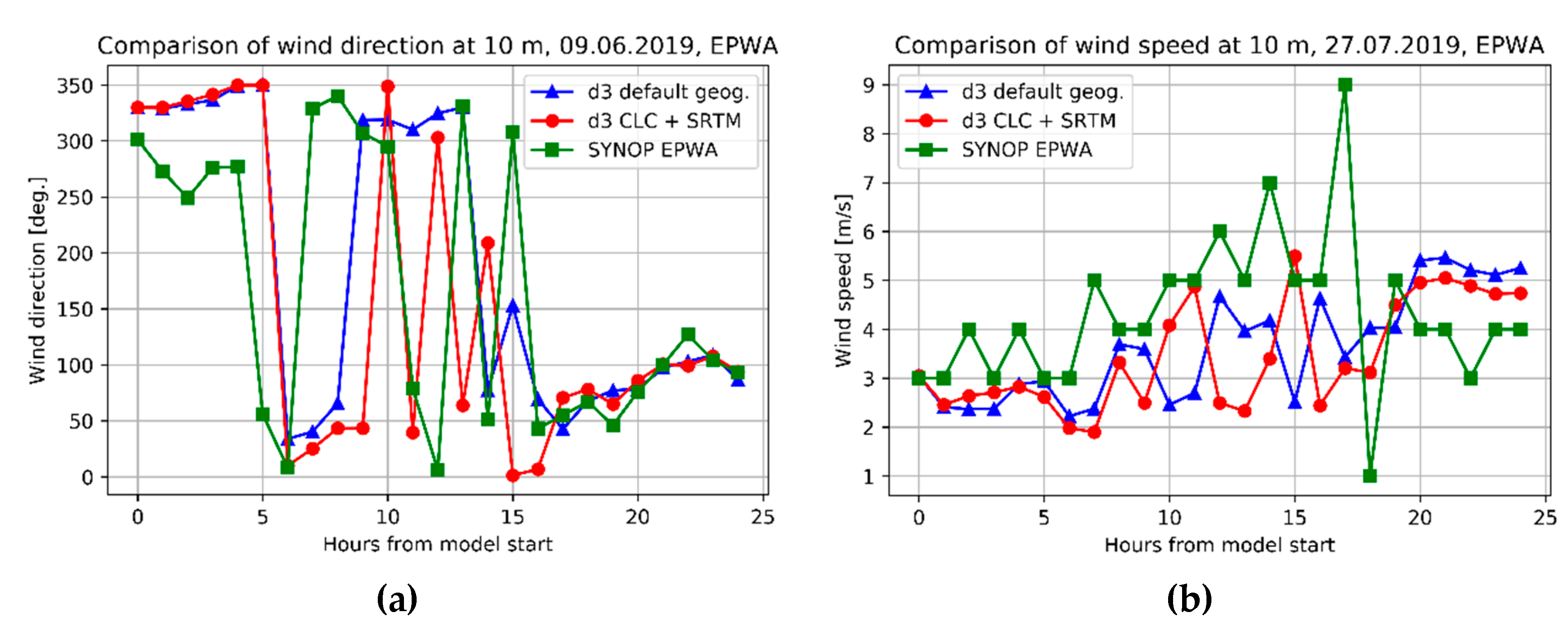
| Location of the Airports | Coordinates of the Airport Meteorological Stations |
|---|---|
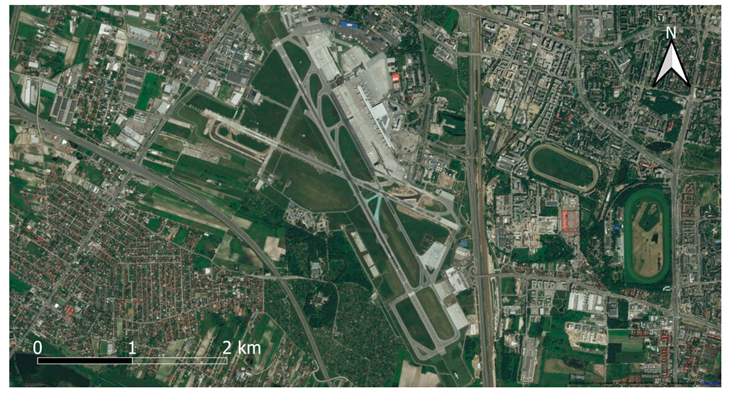 | EPWA 52° 9′ 46″N (52.1629°N) 20° 57′ 40″E (20.9611°E) 110 m (AMSL) |
 | EPBC 52° 16′ 0″N (52.2667°N) 20° 55′ 0″E (20.9167°E) 107 m (AMSL) |
| Parameters | Domains 1/2/3 |
|---|---|
| WRF Version | 4.1 |
| Spin up time, forecast time | 6 h, 24 h |
| Global model gridded data source | GFS 0.25° × 0.25° (3 h interval) [41] |
| Spatial resolution | 5 × 5 km/1 × 1 km/200 × 200 m |
| Geographical data (prepared by the authors for high resolution simulations) | CLC + MODIS + GMTED2010/CLC + SRTM/CLC + SRTM |
| Geographical data (default simulations) | MODIS + GMTED2010/MODIS + GMTED2010/MODIS + GMTED2010 |
| Vertical levels | 60/60/60 |
| Cumulus | Grell-Freitas (Grell et al. 2013)—for all domains |
| Microphysics | WSM6 (Hong and Lim, 2006)/-/- |
| Longwave radiation | RRTMG (Jacono et al., 2008)—for all domains |
| Shortwave radiation | RRTMG (Jacono et al., 2008)—for all domains |
| Surface layer | Revised MM5 Monin-Obukhov scheme (Imenez et al., 2012)—for all domains |
| Planetary boundary layer | Yonsei University scheme—YSU (Hong et al. 2006)/YSU/- |
| Number of CLC Class | Description of CLC Class | Number of MODIS LULC Class | Name of MODIS LULC Class |
|---|---|---|---|
| 111–140, 142 | Urban/Artificial Surfaces | 13 | Urban and Built-Up |
| 141 | Green Urban Areas | 4 | Deciduous Broadleaf Forest |
| 211 | Non-irrigated Arable Land | 12 | Croplands |
| 212 | Permanently Irrigated Land | 12 | Croplands |
| 213 | Rice Fields | 12 | Croplands |
| 221 | Vineyards | 14 | Cropland/Nat. Vegetat. Mosaic |
| 222 | Fruit Trees or Berry Plantations | 14 | Cropland/Nat. Vegetat. Mosaic |
| 223 | Olive Groves | 14 | Cropland/Nat. Vegetat. Mosaic |
| 231 | Pastures | 10 | Grassland |
| 241 | Annual and Permanent Crops | 14 | Cropland/Nat. Vegetat. Mosaic |
| 242 | Complex Cultivation Patterns | 14 | Cropland/Nat. Vegetat. Mosaic |
| 243 | Mixed Agriculture and Natural Vegetation | 14 | Cropland/Natural Vegetation Mosaic |
| 244 | Agro-Forestry Areas | 14 | Cropland/Nat. Vegetat. Mosaic |
| 311 | Broad-Leaved Forest | 4 | Deciduous Broadleaf Forest |
| 312 | Coniferous Forest | 1 | Evergreen Needleleaf Forest |
| 313 | Mixed Forest | 5 | Mixed Forests |
| 321 | Natural Grasslands | 10 | Grasslands |
| 322 | Moors and Heathland | 7 | Open Shrublands |
| 323 | Sclerophyllous Vegetation | 7 | Open Shrublands |
| 324 | Transitional Woodland/Shrub | 7 | Open Shrublands |
| 331 | Beaches, Dunes, Sands | 16 | Barren or Sparsely Vegetated |
| 332 | Bare Rocks | 16 | Barren or Sparsely Vegetated |
| 333 | Sparsely Vegetated Areas | 16 | Barren or Sparsely Vegetated |
| 334 | Burnt Areas | 16 | Barren or Sparsely Vegetated |
| 335 | Glaciers Perpetual Snow | 15 | Snow or Ice |
| 411–423 | Inland Mashes, Peat Bogs, Salt Marshes, Salines, Intertidal Flats | 11 | Permanent Wetlands |
| 511–522 | Inland Waters, Lagoons, Estuaries | 21 | Lakes |
| 523 | Sea and Ocean | 17 | Water |
| Number of CLC Class | Names of CLC Urban Classes | Number of MODIS Class | Name of MODIS LULC Class |
|---|---|---|---|
| 111 | Continuous Urban Fabric | 32 | High-Intensity Residential |
| 112 | Discontinuous Urban Fabric | 31 | Low-Intensity Residential |
| 121 | Industrial or Commercial Units | 33 | Industrial or Commercial |
| 122 | Road and Rail Networks or Associated Land | 33 | Industrial or Commercial |
| 123 | Port Areas | 33 | Industrial or Commercial |
| 124 | Airports | 33 | Industrial or Commercial |
| 131 | Mineral Extraction Sites | 33 | Industrial or Commercial |
| 132 | Dump Sites | 33 | Industrial or Commercial |
| 133 | Construction Sites | 33 | Industrial or Commercial |
| 141 | Green Urban Areas | 4 | Delicious Broadleaf Forest |
| 142 | Sport and Leisure Facilities | 33 | Industrial or Commercial |
| Parameters at EPWA (Time 10:00–15:00 UTC) | ME | MAE | RMSE | MSE | BIAS | R | |
|---|---|---|---|---|---|---|---|
| Temperature (°C) | default geog. | −0.20 | 1.56 | 1.87 | 3.94 | 0.94 | 0.70 |
| CLC + SRTM | 0.32 | 1.41 | 1.68 | 3.54 | 0.98 | 0.67 | |
| Relative humidity (%) | default geog. | 1.43 | 8.11 | 9.36 | 92.60 | 1.04 | 0.73 |
| CLC + SRTM | −3.85 | 7.54 | 8.44 | 96.01 | 0.94 | 0.77 | |
| Wind speed (m/s2) | default geog. | −0.69 | 1.26 | 1.51 | 2.40 | 0.88 | −0.08 |
| CLC + SRTM | −1.06 | 1.48 | 1.78 | 3.28 | 0.79 | −0.02 | |
| Wind direction (°) | default geog. | 10.58 | 27.13 | 31.58 | 1485.27 | 1.11 | 0.11 |
| CLC + SRTM | 4.26 | 29.31 | 34.54 | 2021.31 | 1.08 | 0.28 | |
| Parameters at EPBC (Time 10:00–15:00 UTC) | ME | MAE | RMSE | MSE | BIAS | R | |
|---|---|---|---|---|---|---|---|
| Temperature (°C) | default geog. | −0.09 | 1.13 | 1.44 | 2.59 | 0.97 | 0.54 |
| CLC + SRTM | 0.03 | 1.21 | 1.47 | 2.59 | 0.97 | 0.53 | |
| Relative humidity (%) | default geog. | 0.20 | 6.19 | 7.29 | 66.63 | 1.01 | 0.51 |
| CLC + SRTM | 0.10 | 6.19 | 7.25 | 65.52 | 1.00 | 0.53 | |
| Wind speed (m/s2) | default geog. | −0.24 | 1.19 | 1.58 | 2.96 | 1.01 | −0.41 |
| CLC + SRTM | −0.45 | 1.27 | 1.54 | 2.67 | 0.93 | −0.21 | |
| Wind direction (°) | default geog. | 1.50 | 32.33 | 39.61 | 2712.30 | 1.05 | 0.03 |
| CLC + SRTM | 11.41 | 32.18 | 37.31 | 2280.44 | 1.12 | 0.28 | |
| EPWA | RMSE | |||||||
|---|---|---|---|---|---|---|---|---|
| DATE | T Default Geog. | T CLC + SRTM | RH Default Geog. | RH CLC + SRTM | WS Default Geog. | WS CLC + SRTM | WD Default Geog. | WD CLC + SRTM |
| 26.08.2019 | 1.93 | 1.00 | 7.82 | 1.65 | 1.12 | 2.10 | 27.87 | 24.87 |
| 27.07.2019 | 1.98 | 1.34 | 9.89 | 3.38 | 2.19 | 2.36 | 43.31 | 36.85 |
| 08.06.2019 | 2.93 | 2.72 | 12.42 | 14.44 | 1.67 | 1.89 | 76.91 | 94.49 |
| 20.05.2019 | 2.51 | 2.97 | 11.30 | 13.57 | 1.72 | 1.65 | 20.63 | 16.19 |
| 18.05.2019 | 1.73 | 2.06 | 8.60 | 13.36 | 1.21 | 1.68 | 35.35 | 53.33 |
| 20.01.2020 | 1.22 | 1.05 | 10.32 | 8.05 | 1.47 | 1.37 | 6.15 | 5.79 |
| 21.01.2020 | 0.78 | 0.64 | 5.19 | 4.66 | 1.17 | 1.39 | 10.81 | 10.26 |
| MEAN | 1.87 | 1.68 | 9.36 | 8.44 | 1.51 | 1.78 | 31.58 | 34.54 |
| EPBC | RMSE | |||||||
|---|---|---|---|---|---|---|---|---|
| DATE | T Default Geog. | T CLC + SRTM | RH Default Geog. | RH CLC + SRTM | WS Default Geog. | WS CLC + SRTM | WD Default Geog. | WD CLC + SRTM |
| 26.08.2019 | 1.61 | 1.40 | 4.24 | 3.30 | 1.17 | 1.13 | 27.43 | 20.27 |
| 27.07.2019 | 0.36 | 0.54 | 2.53 | 3.38 | 2.14 | 2.23 | 18.36 | 24.26 |
| 08.06.2019 | 1.77 | 2.27 | 11.32 | 12.53 | 2.81 | 2.22 | 112.79 | 90.61 |
| 20.05.2019 | 2.74 | 2.41 | 12.39 | 10.88 | 1.08 | 1.60 | 29.15 | 22.88 |
| 18.05.2019 | 1.68 | 1.75 | 6.78 | 7.02 | 2.00 | 1.86 | 62.64 | 76.35 |
| 20.01.2020 | 1.12 | 1.09 | 10.05 | 9.87 | 0.94 | 0.83 | 17.82 | 18.00 |
| 21.01.2020 | 0.82 | 0.81 | 3.70 | 3.74 | 0.91 | 0.91 | 9.11 | 8.82 |
| MEAN | 1.44 | 1.47 | 7.29 | 7.25 | 1.58 | 1.54 | 39.61 | 37.31 |
© 2020 by the authors. Licensee MDPI, Basel, Switzerland. This article is an open access article distributed under the terms and conditions of the Creative Commons Attribution (CC BY) license (http://creativecommons.org/licenses/by/4.0/).
Share and Cite
Siewert, J.; Kroszczynski, K. GIS Data as a Valuable Source of Information for Increasing Resolution of the WRF Model for Warsaw. Remote Sens. 2020, 12, 1881. https://doi.org/10.3390/rs12111881
Siewert J, Kroszczynski K. GIS Data as a Valuable Source of Information for Increasing Resolution of the WRF Model for Warsaw. Remote Sensing. 2020; 12(11):1881. https://doi.org/10.3390/rs12111881
Chicago/Turabian StyleSiewert, Jolanta, and Krzysztof Kroszczynski. 2020. "GIS Data as a Valuable Source of Information for Increasing Resolution of the WRF Model for Warsaw" Remote Sensing 12, no. 11: 1881. https://doi.org/10.3390/rs12111881
APA StyleSiewert, J., & Kroszczynski, K. (2020). GIS Data as a Valuable Source of Information for Increasing Resolution of the WRF Model for Warsaw. Remote Sensing, 12(11), 1881. https://doi.org/10.3390/rs12111881




